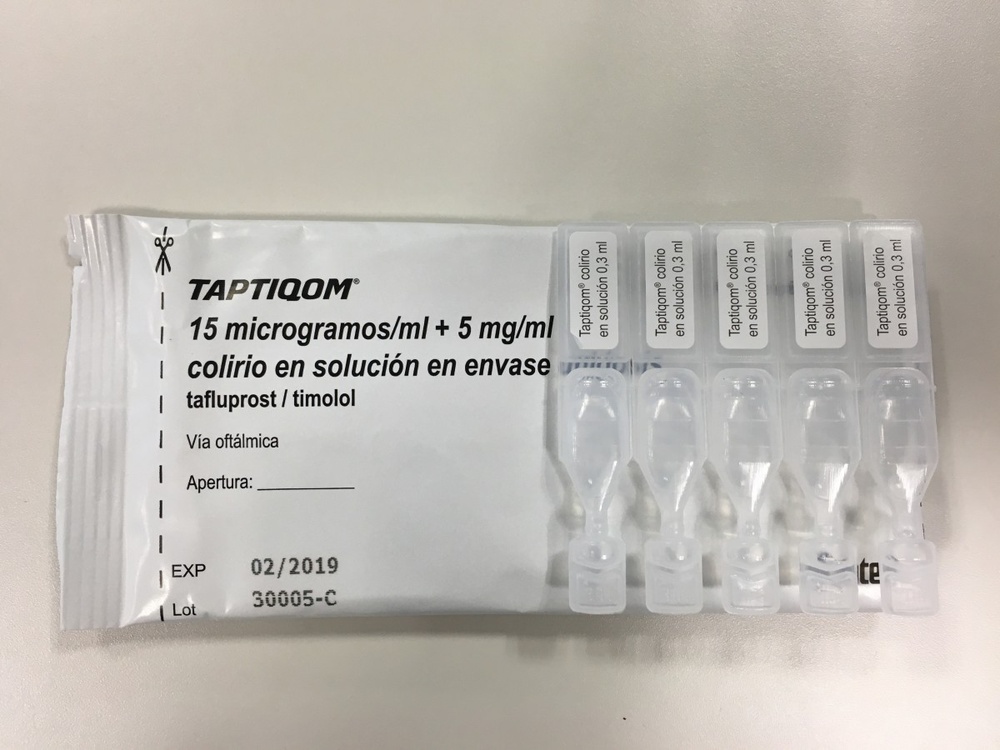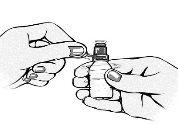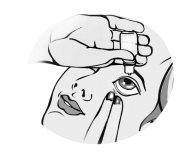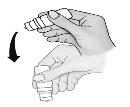

ТАПТІКОМ 15 мікрограм/мл + 5 мг/мл очні краплі, розчин

Запитайте лікаря про рецепт на ТАПТІКОМ 15 мікрограм/мл + 5 мг/мл очні краплі, розчин

Інструкція із застосування ТАПТІКОМ 15 мікрограм/мл + 5 мг/мл очні краплі, розчин
Введення
Опис: Інформація для пацієнта
Таптіком 15 мікрограм/мл + 5 мг/мл офтальмологічний розчин
тафлупрост/тимолол
Перш ніж почати використовувати цей лікарський засіб, уважно прочитайте весь опис, оскільки він містить важливу інформацію для вас.
- Збережіть цей опис, оскільки вам може знадобитися знову його прочитати.
- Якщо у вас є якісь питання, проконсультуйтеся з вашим лікарем, фармацевтом або медсестрою.
- Цей лікарський засіб призначений тільки для вас, і не слід давати його іншим людям, навіть якщо вони мають такі самі симптоми, оскільки це може їм нашкодити.
- Якщо ви відчуваєте побічні ефекти, проконсультуйтеся з вашим лікарем, фармацевтом або медсестрою, навіть якщо це побічні ефекти, які не вказані в цьому описі. Див. розділ 4.
Зміст опису
- Що таке Таптіком і для чого він використовується
- Що потрібно знати перед початком використання Таптіком
- Як використовувати Таптіком
- Можливі побічні ефекти
- Збереження Таптіком
- Зміст упаковки та додаткова інформація
1. Що таке Таптіком і для чого він використовується
Який тип лікарського засобу це і як він діє?
Таптіком офтальмологічний розчин містить тафлупрост і тимолол. Тафлупрост належить до групи лікарських засобів, званих аналогами простагландину, а тимолол належить до групи лікарських засобів, званих бета-блокаторами. Тафлупрост і тимолол діють спільно і знижують тиск ока. Таптіком використовується, коли тиск ока занадто високий.
Для чого використовується ваш лікарський засіб?
Таптіком використовується для лікування типу глаукоми, званого глаукомою відкритого кута, а також стану, званого окулярною гіпертензією у дорослих. Обидва ці стани пов'язані з підвищенням тиску в оці і іноді можуть вплинути на ваш зір.
2. Що потрібно знати перед початком використання Таптіком
Не використовуйте Таптіком:
- якщо ви алергічні на тафлупрост, тимолол, бета-блокатори або будь-які інші компоненти цього лікарського засобу (перелічені в розділі 6).
- якщо у вас є або раніше були проблеми з диханням, такі як астма, хронічна обструктивна хвороба легень (важка хвороба легень, яка може викликати свистіння, труднощі з диханням або тривалу кашель).
- якщо у вас є повільний серцевий ритм, серцева недостатність або порушення серцевого ритму (нерегулярний пульс).
Попередження та застереження
Проконсультуйтеся з вашим лікарем, фармацевтом або медсестрою перед початком використання Таптіком.
Перед використанням цього лікарського засобу повідомте вашому лікареві, якщо у вас є або раніше були:
- серцева хвороба (симптоми можуть включати біль або стиск у грудній клітці, труднощі з диханням або задуха), серцева недостатність або артеріальна гіпотензія
- порушення серцевого ритму, такі як повільні серцеві скорочення
- проблеми з диханням, астма або хронічна обструктивна хвороба легень
- погана циркуляція крові (наприклад, хвороба Рейно або синдром Рейно)
- цукровий діабет, оскільки тимолол може маскувати ознаки та симптоми гіпоглікемії
- гіпертиреоз, оскільки тимолол може маскувати ознаки та симптоми тиреоїдних захворювань
- будь-яка алергія або анафілактична реакція
- важка міастенія (хвороба, яка викликає м'язову слабкість)
- інші окулярні захворювання, такі як хвороба рогівки (прозора тканина, яка покриває передню частину ока) або захворювання, яке потребує окулярної хірургії.
Повідомте вашому лікареві, якщо у вас є
- проблеми з нирками
- проблеми з печінкою.
Вважайте, що Таптіком може мати такі ефекти та що деякі з них можуть бути постійними:
Таптіком може
- збільшити довжину, товщину, колір або густину ваших вій, а також викликати аномальний рост волосся на ваших повіках.
- викликати потемніння шкіри навколо очей. Витирайте надлишок розчину зі шкіри. Таким чином ви зменшите ризик потемніння шкіри.
- змінити колір вашої райдужної оболонки (кольорової частини вашого ока). Якщо ви використовуєте Таптіком тільки в одному оці, колір ока, яке обробляється, може постійно відрізнятися від кольору іншого ока.
- викликати рост волосся в місцях, де розчин вступає в контакт зі шкірою.
Якщо ви плануєте операцію, повідомте вашому лікареві, що ви використовуєте Таптіком, оскільки тимолол може змінити ефекти деяких лікарських засобів, які використовуються під час анестезії.
Діти та підлітки
Таптіком не рекомендується для дітей та підлітків молодше 18 років через відсутність даних про безпеку та ефективність у цій віковій групі.
Використання Таптіком з іншими лікарськими засобами
Повідомте вашому лікареві або фармацевту, якщо ви приймаєте, недавно приймали або думаєте, що можете приймати будь-які інші лікарські засоби.
Таптіком може впливати на або бути під впливом інших лікарських засобів, які ви приймаєте.
Особливо повідомте вашому лікареві, якщо ви використовуєте/приймаєте або плануєте використовувати/приймати:
- інші офтальмологічні лікарські засоби для лікування глаукоми
- лікарські засоби для зниження артеріального тиску
- лікарські засоби для серця
- лікарські засоби для лікування цукрового діабету
- хінідин (використовується для лікування серцевих захворювань та деяких типів малярії)
- антidepressанти, відомі як флуоксетин або пароксетин.
Якщо ви використовуєте інші лікарські засоби в оці, то перед використанням Таптіком пройдіть як мінімум 5 хвилин.
Контактні лінзи
Видаліть контактні лінзи перед використанням крапель і чекайте як мінімум 15 хвилин перед тим, як знову їх вдягнути.
Вагітність, лактація та фертильність
Якщо ви вагітні або годуєте грудьми, думаєте, що можете бути вагітною або плануєте вагітність, проконсультуйтеся з вашим лікарем перед використанням цього лікарського засобу. Якщо ви жінка, яка може вагітніти, ви повинні використовувати ефективний метод контрацепції під час лікування Таптікомом. Не використовуйте Таптіком, якщо ви вагітні, крім випадків, коли це було призначено вашим лікарем. Не використовуйте Таптіком, якщо ви годуєте грудьми. Проконсультуйтеся з вашим лікарем.
Водіння транспортних засобів та використання машин
Деякі побічні ефекти, пов'язані з Таптікомом, такі як розмитий зір, можуть впливати на вашу здатність керувати транспортними засобами або використовувати машини. Не керуйте транспортними засобами та не використовуйте машини, доки ви не почувствуете себе добре та ваш зір не стане чітким.
Таптіком містить фосфати
Цей лікарський засіб містить 1,3 мг фосфатів у кожному мл.
Якщо у вас є важка травма рогівки (прозорої тканини на передній частині ока), лікування фосфатами, в рідких випадках, може викликати розмитий зір через нагромадження кальцію.
3. Як використовувати Таптіком
Слідуйте точно інструкціям з застосування цього лікарського засобу, вказаним вашим лікарем або фармацевтом. У разі сумнівів проконсультуйтеся з вашим лікарем або фармацевтом знову.
Рекомендована доза становить одну краплю Таптікома на день в одне або обидва ока. Не instilайте більше крапель, ніж вказано вашим лікарем. Якщо ви це зробите, Таптіком може втрачати свою ефективність. Використовуйте Таптіком в обидвох очах тільки якщо ваш лікар призначив це.
Для використання тільки як офтальмологічний розчин. Не приймайте всередину.
Не дозволяйте пляшці з краплями торкатися ока чи навколишньої території. Це може пошкодити око. Також це може викликати забруднення бактеріями, які можуть викликати окулярні інфекції, що можуть пошкодити око, включаючи втрату зору. Для避免 можливого забруднення пляшки з краплями уникайте того, щоб наконечник пляшки торкався будь-якої поверхні.
Інструкції з використання:
Коли ви використовуєте його вперше, перед тим як нанести краплю в око, вам потрібно практикувати використання пляшки, стискаючи її повільно, щоб крапля впала поза очима.
Коли ви впевнітеся, що можете нанести одну краплю кожен раз, виберіть найбільш зручну позицію для нанесення крапель (ви можете сидіти, лежати на спині або стояти перед дзеркалом).
При початку нового флакону:
Не використовуйте флакон, якщо пластикове кільце навколо горлечка флакону відсутнє або пошкоджене. Напишіть дату, коли ви відкрили флакон, у призначеному місці на зовнішній коробці.
Кожного разу, коли ви використовуєте Таптіком:
|
|
|
|
Будьте особливо обережні, щоб уникнути того, щоб наконечник флакону з краплями торкався вашого ока, шкіри навколо ока чи ваших пальців, щоб запобігти можливому забрудненню розчину.
Будьте уважні, що може бути невелика затримка між стисканням флакону та падінням краплі. Не стискайте флакон занадто сильно. |
|
|
|
|
|
Залишиться залишковий об'єм близько 1 мл, який не можна вводити. Не намагайтесь спорожнити флакон.
Якщо крапля впала поза оком,спробуйте знову.
Якщо ваш лікар сказав вам нанести краплі в обидва ока, повторіть кроки з 7 до 9 в іншому оці.
Якщо ви використовуєте інші лікарські засоби в оці,пройдіть як мінімум 5 хвилин між нанесенням Таптікома та іншим лікарським засобом.
Якщо ви використовуєте більше Таптікома, ніж потрібно,ви можете відчувати себе дезорієнтованими або мати головний біль, серцеві проблеми чи дихальні проблеми. Якщо це необхідно, проконсультуйтеся з лікарем.
Якщо ви випадково проковтнули лікарський засіб,проконсультуйтеся з лікарем або фармацевтом або зверніться до служби токсикологічної інформації, телефон 91 562 04 20, вказавши лікарський засіб та кількість, яку ви проковтнули.
Якщо ви забули використовувати Таптіком,нанесіть одну краплю, як тільки ви про це вспомните, і поверніться до звичайного режиму. Однак, якщо час наступної дози близько, пропустіть забуту дозу. Не приймайте подвійну дозу, щоб компенсувати забуті дози.
Не припиняйте використання Таптікома без консультації з лікарем. Якщо ви припините лікування Таптікомом, тиск ока знову підвищиться. Це може викликати постійну шкоду оці.
Якщо у вас є будь-які інші питання щодо використання цього лікарського засобу, проконсультуйтеся з вашим лікарем, фармацевтом або медсестрою.
4. Можливі побічні ефекти
Як і всі лікарські засоби, цей лікарський засіб може викликати побічні ефекти, хоча не всі люди їх відчувають. Більшість побічних ефектів не є серйозними.
Зазвичай ви можете продовжувати використовувати краплі, крім випадків, коли ефекти серйозні. У разі сумнівів проконсультуйтеся з лікарем або фармацевтом.
Відомі побічні ефекти використання Таптікома:
Часті побічні ефекти(можуть впливати до 1 особи з 10):
Окулярні розлади
Свербіння очей. Іритація очей. Біль в очах. Червоність очей. Зміни в довжині, товщині та густині вій. Чувство сторонніх предметів в оці. Зміна кольору вій. Чутливість до світла. Розмитий зір.
Рідкі побічні ефекти(можуть впливати до 1 особи з 100):
Розлади нервової системи
Головний біль.
Окулярні розлади
Сухість очей. Червоність повік. Маленькі зони запалення на поверхні ока. Сльозотеча. Опухання повік. Змучені очі. Запалення повік. Запалення всередині ока. Біль в оці. Алергічна реакція на очах. Запалення ока. Аномальне відчуття в оці.
Додаткові побічні ефекти, які були спостережені при використанні лікарських засобів, що складають Таптіком (тафлупрост і тимолол), і тому можуть виникнути при використанні Таптікома:
Побічні ефекти, які були спостережені при використанні тафлупроста:
Окулярні розлади
Зниження здатності ока бачити деталі. Зміна кольору райдужної оболонки (може бути постійною). Зміна кольору шкіри навколо очей. Запалення мембран на поверхні ока. Сльозотеча. Пігментація мембран на поверхні ока. Фолікули на мембранах поверхні ока. Втоптане око. Ірит або увеїт (запалення кольорової частини ока). Едема макули/едематозна макулярна кіста (запалення сітківки всередині ока, що призводить до погіршення зору).
Розлади шкіри
Аномальний рост волосся на повіках.
Ефекти на дихальну систему
Погіршення астми, дихальна недостатність.
Побічні ефекти, які були спостережені при використанні тимолола:
Розлади імунної системи
Алергічні реакції, включаючи запалення під шкірою, кропив'янку та висипку. Алергічна реакція, яка може бути смертельною. Свербіння.
Розлади метаболізму та харчування
Гіпоглікемія.
Психічні розлади
Депресія. Розлади сну. Кошмари. Втрата пам'яті. Нервозність. Галюцинації
Розлади нервової системи
Головокружіння. Слабкість. Аномальні відчуття (такі як оніміння та поколювання). Збільшення симптомів та ознак важкої міастенії (м'язової хвороби). Інсульт. Зменшення кровотоку до мозку.
Окулярні розлади
Запалення рогівки. Зменшення чутливості рогівки. Зорові порушення, включаючи зміни рефракції (іноді через відмову від міотичної терапії). Опущення верхньої повіки. Двоє зору. Розмитий зір та відшарування шару під сітківкою, який містить кровоносні судини, після фільтраційної операції, що може викликати порушення зору. Ерозія рогівки.
Розлади слуху
Тинітус (звон у вухах).
Розлади серцево-судинної системи
Повільний серцевий ритм. Біль у грудній клітці. Серцебиття. Едема (нагромадження рідини). Зміни ритму або швидкості серцевих скорочень. Серцева недостатність (серцева хвороба з труднощами з диханням та набуханням ніг і ступнів через нагромадження рідини). Тип розладу серцевого ритму. Інфаркт міокарда. Серцева недостатність.
Розлади судин
Низький артеріальний тиск. Кожна. Феномен Рейно, холодні руки та ноги.
Розлади дихальної системи
Звільнення дихальних шляхів в легенях (особливо у пацієнтів з попередньою хворобою). Труднощі з диханням. Кашель.
Розлади травної системи
Нудота. Розлад шлунка. Діарея. Сухість у роті. Розлади смаку. Біль у животі. Воміт.
Розлади шкіри
Випадання волосся. Висипка на шкірі з біло-срібним кольором (висипка, подібна до псоріазу) або погіршення псоріазу. Висипка на шкірі.
Розлади м'язів та кісток
Біль у м'язах, який не викликаний фізичними вправами. Біль у суглобах.
Розлади репродуктивної системи та молочних залоз
Хвороба Пейроні (яка може викликати викривлення пеніса). Сексуальна дисфункція. Зменшення лібідо.
Загальні розлади
М'язова слабкість/втома. Спрага.
Звіт про побічні ефекти
Якщо ви відчуваєте будь-які побічні ефекти, проконсультуйтеся з вашим лікарем, фармацевтом або медсестрою, навіть якщо це побічні ефекти, які не вказані в цьому описі. Ви також можете повідомити про них безпосередньо через систему моніторингу лікарських засобів: https;//www.notificaram.es. Надсилаючи повідомлення про побічні ефекти, ви можете допомогти надати більше інформації про безпеку цього лікарського засобу.
5. Збереження Таптікома
Тримайте цей лікарський засіб поза досяжністю дітей.
Не використовуйте цей лікарський засіб після закінчення терміну придатності, вказаного на етикетці флакону та коробки після "CAD". Термін придатності - останній день місяця, який вказано.
Тримайте невідкриті флакони в холодильнику (між 2 та 8 °C). Не заморожуйте.
Тримайте флакон в оригінальній упаковці, щоб захистити його від світла.
Після відкриття флакону:
- Не тримайте при температурі вище 25°C. Не заморожуйте.
- Тримайте флакон в оригінальній коробці, щоб захистити його від світла.
- Після першого відкриття, щоб уникнути інфекцій, флакон потрібно викинути через 3 місяці. Флакон об'ємом 3 мл призначений для використання протягом 1 місяця, флакон об'ємом 5 мл - протягом 2 місяців, а флакон об'ємом 7 мл - протягом 3 місяців.
Лікарські засоби не слід викидати в каналізацію чи сміття. Відкладайте упаковки та лікарські засоби, які вам не потрібні, в пункті збору відходів аптеки. У разі сумнівів проконсультуйтеся з фармацевтом, як позбутися упаковок та лікарських засобів, які вам вже не потрібні. Таким чином, ви допоможете захистити довкілля.
6. Зміст упаковки та додаткова інформація
Склад Таптікома
- Активні речовини - тафлупрост і тимолол. 1 мл розчину містить 15 мікрограмів тафлупросту і 5 мг тимололу (у вигляді малеату).
- Інші компоненти - гліцерол, додекагідрат фосфату дисодію, едетат дисодію, полісорбат 80, хлоридна кислота і/або гідроксид натрію та вода для ін'єкційних препаратів.
Вигляд продукту та вміст упаковки
Таптіком - прозорий і безбарвний рідкий розчин (розчин), практично вільний від видимих частинок. Він випускається в упаковці, що містить 1 прозорий пластиковий флакон, який містить 3 мл, 5 мл або 7 мл, або 3 прозорі пластикові флакони з 3 мл розчину кожний. Пластикові флакони закриті кришками.
Можливо, що тільки деякі розміри упаковок будуть реалізовані.
Власник дозволу на торгівлю та відповідальна особа за виробництво
Власник дозволу на торгівлю
Santen Oy
Нііттюханкаату 20
33720 Тампере
Фінляндія
Відповідальна особа за виробництво
Santen Oy
Келлопортінкату 1
33100 Тампере
Фінляндія
Для отримання додаткової інформації про цей лікарський засіб можна звернутися до місцевого представника власника дозволу на торгівлю:
Santen Pharmaceutical Spain S.L.
Акант, 22, 7-й
28045 – Мадрид
Дата останнього перегляду цього листка: листопад 2021
Детальна та оновлена інформація про цей лікарський засіб доступна на сайті Державного агентства з лікарських засобів та медичних продуктів (AEMPS) http://www.aemps.gob.es/
- Країна реєстрації
- Діючі речовини
- Потрібен рецептТак
- Виробник
- Інформація є довідковою і не є медичною порадою. Перед прийомом будь-яких препаратів обов'язково проконсультуйтеся з лікарем. Oladoctor не несе відповідальності за медичні рішення, прийняті на основі цього контенту.
- Альтернативи до ТАПТІКОМ 15 мікрограм/мл + 5 мг/мл очні краплі, розчинФорма випуску: ОЧНІ КРАПЛІ, 10 мг/мл + 5 мг/млДіючі речовини: timolol, combinationsВиробник: Novartis Europharm LimitedПотрібен рецептФорма випуску: ОЧНІ КРАПЛІ, 0,3 мг/мл + 5 мг/млДіючі речовини: timolol, combinationsВиробник: Brill Pharma S.L.Потрібен рецептФорма випуску: ОЧНІ КРАПЛІ, 0,3 мг/мл + 5 мг/млДіючі речовини: timolol, combinationsВиробник: Laboratorio Stada S.L.Потрібен рецепт
Аналоги ТАПТІКОМ 15 мікрограм/мл + 5 мг/мл очні краплі, розчин в інших країнах
Найкращі аналоги з тією самою діючою речовиною та терапевтичним ефектом.
Аналог ТАПТІКОМ 15 мікрограм/мл + 5 мг/мл очні краплі, розчин у Польша
Аналог ТАПТІКОМ 15 мікрограм/мл + 5 мг/мл очні краплі, розчин у Украина
Лікарі онлайн щодо ТАПТІКОМ 15 мікрограм/мл + 5 мг/мл очні краплі, розчин
Консультація щодо дозування, побічних ефектів, взаємодій, протипоказань та поновлення рецепта на ТАПТІКОМ 15 мікрограм/мл + 5 мг/мл очні краплі, розчин – за рішенням лікаря та згідно з місцевими правилами.



















